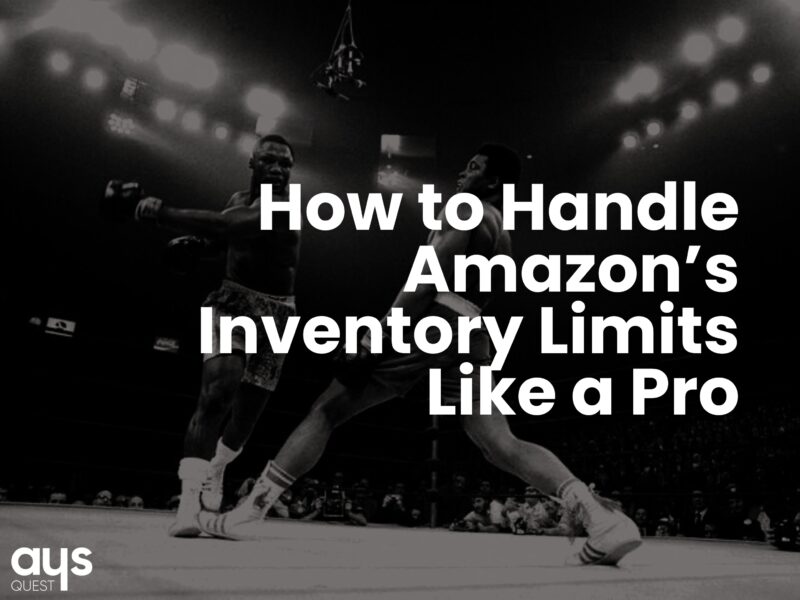Amazon FBA continues to offer sellers unmatched convenience, global reach, and Prime customer trust. However, one challenge that many sellers have faced — and continue to face in 2025 — is Amazon’s inventory limits.
If you’ve ever seen your restock limits shrink or received a warning that your FBA storage is maxed out, you’re not alone. Amazon uses restock and storage limits to manage warehouse space efficiently, especially during peak seasons.
In this blog, you’ll learn how to handle Amazon’s inventory limits like a pro, with practical, tested strategies that help you stay in stock, boost IPI scores, and scale your FBA business without disruption.
What Are Amazon Inventory Limits?

Amazon imposes two types of limits for FBA sellers:
- Storage Volume Limits – Based on cubic feet of space used.
- Restock Limits – Based on the number of units you can send to Amazon.
These limits are influenced by your:
- Inventory Performance Index (IPI)
- Sell-through rate
- Sales velocity
- Excess inventory
- Inbound shipment delays
Limits can fluctuate weekly or quarterly depending on how efficiently you manage your inventory and sales.
Why Amazon Imposes Inventory Limits

Amazon’s FBA warehouses operate under intense demand, especially during Q4, Prime Day, or big sales events. By placing limits, Amazon ensures:
- Fast delivery times for customers
- Better warehouse efficiency
- Reduced overstocking from sellers
- Balanced space allocation for high-performing products
Unfortunately, these limits can hinder sellers who want to scale aggressively or launch new SKUs.
But with the right strategies, you can work around these limits and grow consistently.
7 Pro Strategies to Handle Amazon Inventory Limits in 2025

1. Optimize Your Inventory Performance Index (IPI)

Your IPI score (scale of 0–1000) is one of the biggest factors in determining your storage limits. A score above 400 (Amazon’s benchmark) is essential to avoid penalties or tight limits.
How to improve your IPI:
- Reduce excess inventory: Create removal orders or run promotions.
- Increase sell-through rate: Bundle slow-movers with bestsellers.
- Keep products in stock: Avoid going out-of-stock on high-demand SKUs.
- Fix stranded inventory: Use Amazon’s Fix Stranded Inventory tool regularly.
Pro Tip: Check your IPI dashboard weekly inside Seller Central and take action proactively.
2. Use a Third-Party Logistics (3PL) Partner

One of the smartest ways to handle restock limits is by using a 3PL provider to store your extra inventory.
- Send only a portion of your stock to FBA.
- Keep the rest with your 3PL, ready to replenish.
- Replenish Amazon based on demand and limits.
This strategy helps you stay agile, reduce storage fees, and avoid stockouts.
3. Forecast Demand More Accurately

Misjudging demand is a common cause of overstocking or understocking. Accurate forecasting ensures that you’re sending the right quantity of the right SKUs.
Use tools like:
- Amazon’s Restock Inventory Tool
- Inventory Planner
- Forecastly
- Helium 10 Demand Planner
Adjust forecasts for seasonal demand, Prime Day boosts, or new product launches.
4. Split Shipments and Prioritize Fast-Movers

When faced with a limit, prioritize your top-selling SKUs. Don’t waste your restock allowance on slow-movers.
What you can do:
- Ship smaller batches more frequently.
- Split shipments between Amazon and 3PL.
- Focus on replenishing products with a high sales velocity.
Result: Your most profitable SKUs stay in stock and continue generating sales.
5. Create Removal Orders for Dead Stock

Dead stock eats up your storage space and hurts your IPI score.
Amazon charges long-term storage fees for items sitting in FBA for over 365 days, which directly impacts your profit margins.
Solutions:
- Create removal orders for products with poor sales.
- Run clearance deals, Lightning Deals, or coupons.
- Liquidate or relabel to make bundles or smaller packs.
This frees up room for better-performing products and improves your account health.
6. Diversify Fulfillment Options (FBM + FBA)

A hybrid model combining FBA and FBM (Fulfilled by Merchant) allows you to continue selling even when FBA limits restrict inventory flow.
Benefits of using FBM:
- No warehouse restrictions from Amazon
- Great for slow-moving or oversized products
- Flexibility during FBA delays
Tip: Use FBM temporarily for new SKUs until they gain traction, then switch to FBA once the demand justifies it.
7. Monitor Inventory Reports & Plan Ahead

Keep a close watch on these essential inventory reports:
- Restock Inventory Report
- Inventory Age Report
- FBA Inventory Health Report
- Stranded Inventory Report
Set monthly or weekly routines to review your inventory health and set alerts when storage or restock limits are approaching.
Planning ahead is crucial — don’t wait until peak season to act!
Bonus Tip: Leverage Amazon Warehousing and Distribution (AWD)

Amazon’s AWD service allows sellers to store inventory in bulk and replenish multiple marketplaces (FBA or direct-to-customer) with ease.
This is a great solution for sellers looking to:
- Offload excess inventory
- Support both B2B and B2C channels
- Bypass short-term restock limitations
AWD is rapidly becoming a go-to solution for brands scaling on and off Amazon.
Conclusion: Take Control of Amazon Inventory Limits

Amazon inventory limits are here to stay — but they don’t have to limit your growth. With the right tools, strategies, and proactive planning, you can handle Amazon’s storage and restock limits like a pro and scale your FBA business with confidence in 2025.
Whether you use a 3PL, optimize your IPI, or diversify fulfillment, the key is to stay agile and data-driven.





